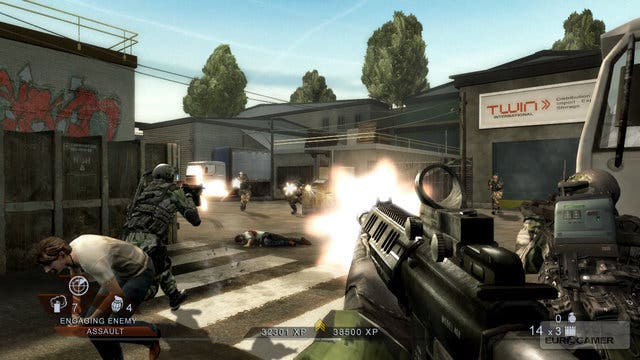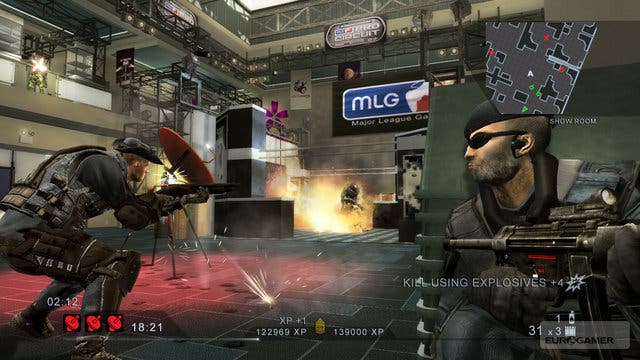Tom Clancy's Rainbow Six Vegas 2
Royale with cheese.
I'll bring this up again since everyone seems to have forgotten: Ubisoft used to call these games "standalone expansion packs". Everyone knew where they stood. What you were getting was more of the same; new levels built on the same tech with the exact same gameplay, and, as a result, a price tag of less than twenty quid. Take Rainbow Six 3: Black Arrow, and Ghost Recon 2: Summit Strike - great examples of fan service, and we gave both 8/10. Had they been full-price, we might have been grumpier about what were blatant retreads, albeit quality ones. It's all about context.
But since the so-called next generation rolled into town, that approach has been replaced with near-annual updates dressed up as full sequels. GRAW 2 just about got away with it last year, mainly because it was a far more polished offering than the unfinished original and everything it should have been in the first place. Rainbow Six Vegas, though, got most things right first time. More of the same is just...well, going over old ground.
Lasting just seven 'acts' (over 25 scenes each lasting about 10-15 minutes), the single-player campaign is woefully short-lived. Putting the game on at 10am on a leisurely Sunday morning, I'd finished the whole thing before my belly started rumbling for an evening meal - and that's factoring in numerous breaks for snacks, IM chats and idle net-browsing. Your mileage will vary related to difficulty level and your ability to nail terrorists, but the ongoing trend for shorter single-player experiences in blockbuster releases is blatantly in evidence here, with six hours likely to be the average first run-through for most.

Kicking off in Paris five years before the game's near-future setting, the game quickly moves on to the neon trash of Sin City once again, where those dastardly terrorists are up to no good with chemical weapons. "No good", of course, gives us the excuse to shoot some more funny foreigners. Wacka-wacka. The story's not exactly the game's strong point, with a typically anodyne cast and dialogue that washes over you, but, for once, the scale of the task at hand seems credible. It's a slightly more personal affair, where your best efforts don't always yield the desired results. The entire universe isn't going to perish at the hands of someone with short man syndrome or anything; trying to stop trains from blowing up, people being gassed to death and hotels exploding seems a bit more like the sort of thing Rainbow Six would be tasked with.
For the fourth game in a row (if we include both GRAWs), each mission is book-ended by Ubisoft's trademark chopper ride to your destination, complete with stunning, popup-free views. Admittedly the impressiveness of the effect is somewhat dimmed by its predictability and recent over-use, but it's still one of the best ways to get a mission underway, with your briefings and background details formed from the chatter during the journey. On the ground, it conforms to the Rainbow Six template - train stations, office complexes, underground car parks hotels, rooftops, blah - with alternative routes through levels on offer and, thankfully, very little to do on the casino floor (handy, since we left all our money at the games shop).

As Bishop, the leader of a three-man squad, you have the option of leading the charge and letting your two team-mates fall in behind you, or playing the cautious tactician and allowing them to take all the risks. Using your men as a battering ram serves as an effective tactic, with their ability to soak up damage curiously far greater than yours - especially if you crank the difficulty level up to Realistic. Employing a recharging health mechanic, this is undoubtedly a far more forgiving affair (even on hard difficulty) than the rather evil old-school Rainbow Sixes, with a fair few checkpoints helping to accelerate progress and minimise the incessant replaying of certain sections. So that's one reason it's a shorter game than it used to be, but let's not forget that seven campaign levels is fewer than usual as well.
While we ponder over the fine detail, it's easy to forget how refined the control system is, and how well it serves a once-complex game. The slick system employed allows you to move freely while dictating the position of your men - whether stacking them up against the next door or requesting them to fall in behind you. Using a combination of context-sensitive commands and intuitive d-pad commands, the game second-guesses your intentions correctly. You can make use of cover by holding the left trigger near to where you want to go, moving the left stick to peek out in the required direction, with options to blindfire too. The overall range of commands has been reduced since, say, 2004's disappointing Lockdown, but all the essentials remain, like being able to frag or flash and then clear, and tagging enemies you want your team-mates to take out first with the left bumper. Ill-advised additions like heartbeat sensors and overly convoluted go-codes are firmly in the dustbin of history, it seems.









